UNIT 3
MULTIVARIABLE CALCULUS (DIFFERENTIATION)
Function of two variables- R denotes the set of real numbers. Let’s D is a collection of pairs of real numbers (x, y), which means D is a subset of R × R.
Then a real valued function of two variables of f is a rule that assign to each point (x,y) in D a unique real number denoted by f(x,y).
The set D is called the domain of f.
The set [ f(x,y) : (x,y) belongs to D ], which is the set of values the function f takes, is called range of f.
Here we generally use the letter z to denote the value that a function of two variables takes,
Then we will have,
z = f(x, y)
Here we will call that z is the dependent variable and x and y are independent variables.
Example-1: The area of a rectangular figure whose length is l and breadth is b, given by l × b.
Here independent variables are l and b, but dependent variable is area.
Example-2: the volume of a cylinder is given by πr²h, where r is the radius and h is the height of the cylinder.
In which radius and height are independent variables and volume is dependent.
Example-3: the volume of cuboid is given by l × b× h. Where l, b and h are the length, breadth and height respectively.
L, b and h are independent variable and volume of cuboid is dependent variable.
Limits-
The function f(x,y) is said to tend to limit ‘l’ , as x →a and y→b Iff the limit is dependent on point (x,y) as x →a and y→b
We can write this as,

Example-1: evaluate the 
Sol. We can simply find the solution as follows,

Example-2: evaluate 
Sol.
 -6.
-6.
Example-3: evaluate 
Sol.

Conitinuity –
At point (a,b) , a function f(x,y) is said to be continuous if,

Working rule for continuity-
Step-1: f(a,b) should be well defined.
Step-2:  should exist.
should exist.
Step-3: 
Example-1: Test the continuity of the following function-

Sol. (1) the function is well defined at (0,0)
(2) check for the second step,


That means the limit exists at (0,0)
Now check step-3:


So that the function is continuous at origin.
Example-2: check for the continuity of the following function at origin,

Sol. (1) Here the function is well defined at (0,0)
(2) Check for second step-

Limit f is not unique for different values of m
So that the limit does not exists.
Therefore the function is not continuous at origin.
Steps to check for existence of limit-
Step-1: find the value of f(x,y) along x →a and y→b
Step-2: find the value of f(x,y) along x →b and y→a
Note- if the values in step -1 and step-2 are same then we can say that the limits exist otherwise not.
Step-3: if a →0 and b→0 then find the limit along y =mx, if the value does not contain m then limit exist, If it contains m then the limit does not exist.
Note-1- put x = 0 and y = 0 in f, then find f1
2 - Put y = 0 and x = 0 In f then find x2
If f1 and f2 are equal then limit exist otherwise not.
3- put y = mx then find f3
If f1 = f2 ≠f3, limit does not exist.
4- put y = mx² and find f4,
If f1 = f2 = f3 ≠ f4, limit does not exist
If f1 = f2 = f3 = f4, limit exist.
Example-1: Evaluate 
Sol . 1. 
2. 
Here f1 = f2
3. Now put y = mx, we get

Here f1 = f2 = f3
Now put y = mx²
4. 
Therefore,
F1 = f2 = f3 =f4
We can say that the limit exists with 0.
Example-2: evaluate the following-

Sol. First we will calculate f1 –
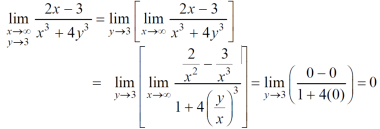
Here we see that f1 = 0
Now find f2,

Here , f1 = f2
Therefore the limit exists with value 0.
First order partial differentiation-
Let f(x, y) be a function of two variables. Then the partial derivative of this function with respect to x can be written as  and defined as follows:
and defined as follows:
 =
= 
Now the partial derivative of f with respect to f can be written as  and defined as follows:
and defined as follows:
 =
= 
Note: a. While calculating partial derivatives treat all independent variables, other than the variable with respect to which we are differentiating, as constant.
b. We apply all differentiation rules.
Higher order partial differentiation-
Let f(x , y) be a function of two variables. Then its second-order partial derivatives, third order partial derivatives and so on are referred as higher order partial derivatives.
These are second order four partial derivatives:
(a)  =
= 
(b)  =
= 
(c)  =
= 
(d)  =
= 
b and c are known as mixed partial derivatives.
Similarly we can find the other higher order derivatives.
Example-1: - Calculate  and
and  for the following function
for the following function
f(x , y) = 3x³-5y²+2xy-8x+4y-20
Sol. To calculate  treat the variable y as a constant, then differentiate f(x,y) with respect to x by using differentiation rules,
treat the variable y as a constant, then differentiate f(x,y) with respect to x by using differentiation rules,
 =
=  [3x³-5y²+2xy-8x+4y-20]
[3x³-5y²+2xy-8x+4y-20]
=  3x³] -
3x³] -  5y²] +
5y²] +  [2xy] -
[2xy] - 8x] +
8x] + 4y] -
4y] -  20]
20]
= 9x² - 0 + 2y – 8 + 0 – 0
= 9x² + 2y – 8
Similarly partial derivative of f(x,y) with respect to y is:
 =
=  [3x³-5y²+2xy-8x+4y-20]
[3x³-5y²+2xy-8x+4y-20]
=  3x³] -
3x³] -  5y²] +
5y²] +  [2xy] -
[2xy] - 8x] +
8x] + 4y] -
4y] -  20]
20]
= 0 – 10y + 2x – 0 + 4 – 0
= 2x – 10y +4.
Example-2: Calculate  and
and  for the following function
for the following function
f( x, y) = sin(y²x + 5x – 8)
Sol. To calculate  treat the variable y as a constant, then differentiate f(x,y) with respect to x by using differentiation rules,
treat the variable y as a constant, then differentiate f(x,y) with respect to x by using differentiation rules,

 [sin(y²x + 5x – 8)]
[sin(y²x + 5x – 8)]
= cos(y²x + 5x – 8) (y²x + 5x – 8)
(y²x + 5x – 8)
= (y² + 50) cos(y²x + 5x – 8)
Similarly partial derivative of f(x,y) with respect to y is,

 [sin(y²x + 5x – 8)]
[sin(y²x + 5x – 8)]
= cos(y²x + 5x – 8) (y²x + 5x – 8)
(y²x + 5x – 8)
= 2xy cos(y²x + 5x – 8)
Example-3: Obtain all the second order partial derivative of the function:
f( x, y) = ( x³y² - xy⁵)
Sol.  3x²y² - y⁵,
3x²y² - y⁵,  2x³y – 5xy⁴,
2x³y – 5xy⁴,
 =
=  = 6xy²
= 6xy²
 =
=  2x³ - 20xy³
2x³ - 20xy³
 =
=  = 6x²y – 5y⁴
= 6x²y – 5y⁴
 =
=  = 6x²y - 5y⁴
= 6x²y - 5y⁴
Example-4: Find

Sol. First we will differentiate partially with repsect to r,


Now differentiate partially with respect to θ, we get


Example-5: if,

Then find.

Sol-
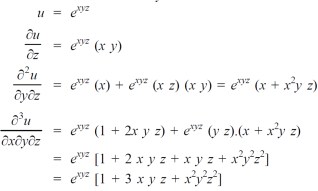
Example-6: if  , then show that-
, then show that- 
Sol. Here we have,
u =  …………………..(1)
…………………..(1)
Now partially differentiate eq.(1) w.r to x and y , we get

= 
Or

 ………………..(2)
………………..(2)
And now,


= 
 ………………….(3)
………………….(3)
Adding eq. (1) and (3) , we get


 = 0
= 0
Hence proved.
When we measure the rate of change of the dependent variable owing to any change in a variable on which it depends, when none of the variable is assumed to be constant.
Let the function, u = f( x, y), such that x = g(t) , y = h(t)
ᵡ Then we can write,
 =
= 
= 
This is the total derivative of u with respect to t.
Change of variable-
If w = f (x, y) has continuous partial variables fx and fy and if x = x (t), y = y (t) are
Differentiable functions of t, then the composite function w = f (x (t), y (t)) is a
Differentiable function of t.
In this case, we get,
 fx (x (t), y (t)) x’ (t) + fy (x(t), y (t)) y’ (t).
fx (x (t), y (t)) x’ (t) + fy (x(t), y (t)) y’ (t).
Example-:1 let q = 4x + 3y and x = t³ + t² + 1 , y = t³ - t² - t
Then find  .
.
Sol. :  . =
. = 
Where, f1 =  , f2 =
, f2 = 
In this example f1 = 4 , f2 = 3
Also,  3t² + 2t ,
3t² + 2t , 
 4(3t² + 2t) + 3(
4(3t² + 2t) + 3(
= 21t² + 2t – 3
Example-2: Find  if u = x³y⁴ where x = t³ and y = t².
if u = x³y⁴ where x = t³ and y = t².
Sol. As we know that by definition,  =
= 
 3x²y⁴3t² + 4x³y³2t = 17t¹⁶.
3x²y⁴3t² + 4x³y³2t = 17t¹⁶.
Example-3: if w = x² + y – z + sint and x + y = t, find
(a)  y,z
y,z
(b)  t, z
t, z
Sol. With x, y, z independent, we have
t = x + y, w = x² + y - z + sin (x + y).
Therefore,
 y,z = 2x + cos(x+y)
y,z = 2x + cos(x+y) (x+y)
(x+y)
= 2x + cos (x + y)
With x, t, z independent, we have
Y = t-x, w= x² + (t-x) + sin t
Thus  t, z = 2x - 1
t, z = 2x - 1
Example-4: If u = u( y – z , z - x , x – y) then prove that  = 0
= 0
Sol. Let,

Then,

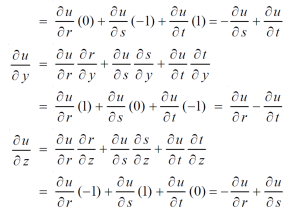
By adding all these equations we get,
 = 0 hence proved.
= 0 hence proved.
Example-5: if φ( cx – az , cy – bz) = 0 then show that ap + bq = c
Where p =  q =
q = 
Sol. We have,
φ( cx – az , cy – bz) = 0
φ( r , s) = 0
Where,
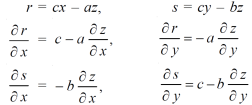
We know that,
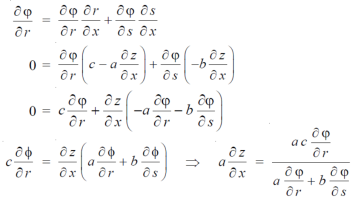
Again we do,
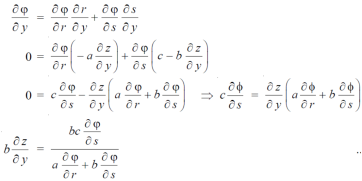
By adding the two results, we get


Example-6: If z is the function of x and y , and x =  , y =
, y =  , then prove that,
, then prove that,

Sol. Here , it is given that, z is the function of x and y & x , y are the functions of u and v.
So that,
 ……………….(1)
……………….(1)
And,
 ………………..(2)
………………..(2)
Also there is,
x =  and y =
and y =  ,
,
Now,
 ,
,  ,
,  ,
, 
From equation(1) , we get
 ……………….(3)
……………….(3)
And from eq. (2) , we get
 …………..(4)
…………..(4)
Subtracting eq. (4) from (3), we get

 =
=  )
)  – (
– (
= x
Hence proved.
Differentiability-
Let f(x) be a single valued function of the variable x, then,
f’(x) = 
Provided that the limit exists and is dependent of the path along which 
Example: suppose that the function,
f(z) = 4x + y + i( -x + 4y)
Discuss df/dz.
Sol. Here,



Example-2: if

Then df/dz , z = 0.
Sol.
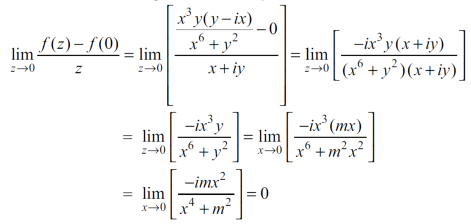
A composite function is a composition / combination of the functions. In this value of one function depends on the value of another function. A composite function is created when one function is put in another.
Let 
i.e 
To differentiate composite function chain rule is used:
Chain rule:
- If
 where x,y,z are all the function of t then
where x,y,z are all the function of t then

2. If  be an implicit relation between x and y .
be an implicit relation between x and y .
Differentiating with respect to x we get

We get 
Example 1 : If  where
where  then find the value of
then find the value of  ?
?
Given 
Where 
By chain rule




Now substituting the value of x ,y,z we get
 -6
-6

 8
8
Example2 :If  then calculate
then calculate 
Given 
By Chain Rule





Putting the value of u = 

Again partially differentiating z with respect to y
By Chain Rule



 by substituting value
by substituting value 

Example 3 :If  .
.
Show that 
Given 
Partially differentiating u with respect to x and using chain rule


 ………(i)
………(i)
Partially differentiating z with respect to y and using chain rule


=  ………..(ii)
………..(ii)
Partially differentiating z with respect to t and using chain rule


Using (i) and (ii) we get

Hence 
Example4 : If  where the relation is
where the relation is  .
.
Find the value of 
Let the given relation is denoted by 
We know that 
Differentiating u with respect to x and using chain rule



Example5 : If  and the relation is
and the relation is  . Find
. Find 
Given relation can be rewrite as
 .
.
We know that

Differentiating u with respect to x and using chain rule



Implicit differentiation-
Let f(x,y) = 0
Where y = ∅(x)
By the chain rule , with x = x and y = ∅(x), we get


Here we assume that y is a differentiable funtion of x.
Example-1: if ∅ is a differentiable function such that y = ∅(x) satisfies the equation
x³ + y³ +sin xy = 0 then find  .
.
Sol. Suppose f(x,y) = x³ + y³ +sin xy
Then,
fᵡ = 3x² + y cos xy
Fy = 2y + x cos xy
So ,

Example-2:

Sol. Take partial derivative on both side w.r. t. x, treat y as constant
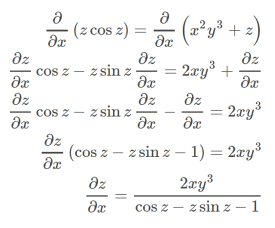
Example-3: if x²y³ + cos y cos z = x² cos x sin y, then find 
Sol. Differentiate partially w.r.t. x and treat y as constant,
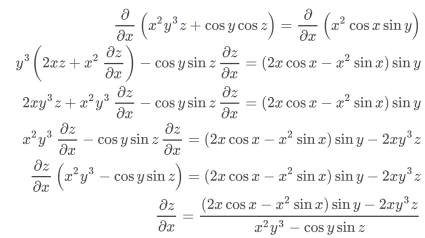
Let us suppose we have,
z = f(x , y)
Where, x = g(u , v)
And y = h(u , v)
Then,

And

Let’s do some examples-
Example-1: If u = u( ), then prove that
), then prove that  .
.
Sol. We are given that,
u = u ( ) = u( r , s)
) = u( r , s)
Where r =  and s =
and s = 
Or we can write as-
r =  and s =
and s = 
Differentiate them partially with respect to x , y and z. , we get











As we know that-

Then,

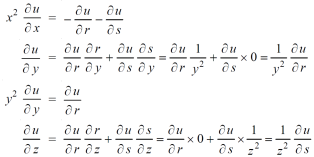

Adding all these results, we get
 .
.
Example-2: If u = x³ + y³ where x = a cos t and y = b sint , then find du/dt.
Sol. Given,
u = x³ + y³
x = a cost and y = b sint

= (3x²)(-a sint) + (3y²) (b cost)
= -3a³cos²t sint + 3b³sin²t cost
If u and v are functions of the two independent variables x and y , then the determinant,

Is known as the jacobian of u and v with respect to x and y, and it can be written as,

Suppose there are three functions u , v and w of three independent variables x , y and z then,
The Jacobian can be defined as,

Important properties of the Jacobians-
Property-1-
If u and v are the functions of x and y , then

Proof- Suppose u = u(x,y) and v = v(x,y) , so that u and v are the functions of x and y,
Now,

Interchange the rows and columns of the second determinant, we get
= 
=  ………….(1)
………….(1)
Differentiate u = u(x,y) and v= v(x,y) partially w.r.t. u and v, we get







Putting these values in eq.(1) , we get
 hence proved.
hence proved.
Property-2:
Suppose u and v are the functions of r and s, where r,s are the fuctions of x , y, then,

Proof:  =
= 
Interchange the rows and columns in second determinant
We get,
= 
= 
=  =
= 
Similarly we can prove for three variables.
Property-3
If u,v,w are the functions of three independent variables x,y,z are not independent , then,

Proof: here u,v,w are independent , then f(u,v,w) = 0 ……………….(1)
Differentiate (1), w.r.t. x, y and z , we get
 …………(2)
…………(2)
 ………………(3)
………………(3)
 ………………..(4)
………………..(4)
Eliminate  from 2,3,4 , we get
from 2,3,4 , we get

Interchanging rows and columns, we get

 = 0
= 0
So that,

Example-1: If x = r sin , y = r sin
, y = r sin , z = r cos
, z = r cos , then show that
, then show that
 sin
sin also find
also find 
Sol. We know that,


= 
= 
=  (on solving the determinant)
(on solving the determinant)
= 
Now using first property of Jacobians, we get

Example-2: If u = x + y + z , uv = y + z , uvw = z , find 
Sol. Here we have,
x = u – uv = u(1-v)
y = uv – uvw = uv( 1- w)
And z = uvw
So that,

 =
=
Apply 
=
Now we get,
= u²v(1-w) + u²vw
= u²v
Example-3: If u = xyz , v = x² + y² + z² and w = x + y + z, then find J = 
Sol. Here u ,v and w are explicitly given , so that first we calculate
J’ = 
J’ =  =
= 
= yz(2y-2z) – zx(2x – 2z) + xy (2x – 2y) = 2[yz(y-z)-zx(x-z)+xy(x-y)]
= 2[x²y - x²z - xy² + xz² + y²z - yz²]
= 2[x²(y-z) - x(y² - z²) + yz (y – z)]
= 2(y – z)(z – x)(y – x)
= -2(x – y)(y – z)(z – x)
By the property,
JJ’ = 1
J = 
When we differentiate a function depend on more than one independent variable, we differentiate it with respect to one variable keeping other as constant.
A second order partial derivative means differentiating twice
In general  are also function of x and y and so these can be further partially differentiated with respect to x and y.
are also function of x and y and so these can be further partially differentiated with respect to x and y.






In general 
Notation:
Generalization: If 
Then the partial derivative of z with respect to  is obtained by differentiating z with respect to
is obtained by differentiating z with respect to  treating all the other variables as constant and is denoted by
treating all the other variables as constant and is denoted by

Example1: If  . Then prove that
. Then prove that

Given 
Partially differentiating z with respect to x keeping y as constant


Again partially differentiating given z with respect to y keeping x as constant


On b.eq(i) +a.eq(ii) we get

Hence proved.
Example2 : If 
Show that 
Given 
Partially differentiating z with respect to x keeping y as constant

Again partially differentiating z with respect to x keeping y as constant


Partially differentiating z with respect to y keeping x as constant

Again partially differentiating z with respect to y keeping x as constant

From eq(i) and eq(ii) we conclude that

Example3 : Find the value of n so that the equation

Satisfies the relation 
Given 
Partially differentiating V with respect to r keeping  as constant
as constant

Again partially differentiating given V with respect to  keeping r as constant
keeping r as constant

Now, we are taking the given relation

Substituting values using eq(i) and eq(ii)











On solving we get 
Example 4 : If  then show that when
then show that when 

Given 
Taking log on both side we get

Partially differentiating with respect to x we get


 …..(i)
…..(i)
Similarly partially differentiating with respect y we get
 ……(ii)
……(ii)
LHS : 

Substituting value from (ii)


Again substituting value from (i) we get
 ]
]

When 





=RHS
Hence proved
Example5 :If 
Then show that 
Given 
Partially differentiating u with respect to x keeping y and z as constant

Similarly partially differentiating u with respect to y keeping x and z as constant

 …….(ii)
…….(ii)
Similarly partially differentiating u with respect to z keeping x and y as constant

 …….(iii)
…….(iii)
LHS: 






Hence proved
Taylor’s Theorem-
If f(x + h) is a function of h which can be expanded in the ascending powers of h and is differentiable by any number of times with respect to h, then-
 + …….+
+ …….+  + ……..
+ ……..
Which is called Taylor’s theorem.
If we put x = a, we get-
 + …….+
+ …….+  + …….. (1)
+ …….. (1)
Maclaurin’s Theorem-
If we put a = 0 and h = x then equation(1) becomes-
 + …….
+ …….
Which is called Maclaurin’s theorem.
Note – if we put h = x - a then there will be the expansion of F(x) in powers of (x – a)
We get-
 + …….
+ …….
Example-1: Express the polynomial  in powers of (x-2).
in powers of (x-2).
Sol. Here we have,
f(x) = 
Differentiating the function w.r.t.x-
f’(x) = 
f’’(x) = 12x + 14
f’’’(x) = 12
f’’’’(x)=0
Now using Taylor’s theorem-
 + ……. (1)
+ ……. (1)
Here we have, a = 2,
Put x = 2 in the derivatives of f(x), we get-
f(2) = 
f’(2) = 
f’’(2) = 12(2)+14 = 38
f’’’(2) = 12 and f’’’’(2) = 0
Now put a = 2 and substitute the above values in equation(1), we get-



Taylor’s theorem for functions of two variables-
Suppose f(x , y) be a function of two independent variables x and y. Then,
 + ……………
+ ……………
Maclaurin’s series is the special case of Taylor’s series-
When we put a = 0 and b = 0 (about origin) in Taylor’s series, we get-
 + ……………
+ ……………
Example-2: Expand f(x , y) =  in powers of x and y about origin.
in powers of x and y about origin.
Sol. Here we have the function-
f(x , y) = 
Here , a = 0 and b = 0 then
f(0 , 0) = 
Now we will find partial derivatives of the function-
















Now using Taylor’s theorem-
 +………
+………
Suppose h = x and k = y , we get
 +…….
+…….
=  +……….
+……….
Example-3: Find the Taylor’s expansion of  about (1 , 1) up to second degree term.
about (1 , 1) up to second degree term.
Sol. We have,

At (1 , 1)
















Now by using Taylor’s theorem-
 ……
……
Suppose 1 + h = x then h = x – 1
1 + k = y then k = y - 1
 ……
……
 =
= 
 ……..
……..
As we know that the value of a function at maximum point is called maximum value of a function. Similarly the value of a function at minimum point is called minimum value of a function.
The maxima and minima of a function is an extreme biggest and extreme smallest point of a function in a given range (interval) or entire region. Pierre de Fermat was the first mathematician to discover general method for calculating maxima and minima of a function. The maxima and minima are complement of each other.
Maxima and Minima of a function of one variables
If f(x) is a single valued function defined in a region R then
Maxima is a maximum point  if and only if
if and only if 
Minima is a minimum point  if and only if
if and only if 
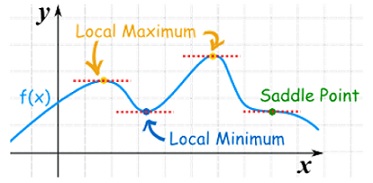
Maxima and Minima of a function of two independent variables
Let  be a defined function of two independent variables.
be a defined function of two independent variables.
Then the point  is said to be a maximum point of
is said to be a maximum point of  if
if

Or  =
= 
For all positive and negative values of h and k.
Similarly the point  is said to be a minimum point of
is said to be a minimum point of  if
if

Or  =
= 
For all positive and negative values of h and k.
Saddle point: Critical points of a function of two variables are those points at which both partial derivatives of the function are zero. A critical point of a function of a single variable is either a local maximum, a local minimum, or neither. With functions of two variables there is a fourth possibility - a saddle point.
A point is a saddle point of a function of two variables if
![2 2 [ 2 ] 2
@f-= 0, @f--= 0, and @-f- @-f-- -@-f- < 0
@x @y @x2 @y2 @x @y](https://glossaread-contain.s3.ap-south-1.amazonaws.com/epub/1643158335_0578706.png)
At the point.
Stationary Value
The value  is said to be a stationary value of
is said to be a stationary value of  if
if

i.e. the function is a stationary at (a , b).
Rule to find the maximum and minimum values of 
- Calculate
 .
. - Form and solve
 , we get the value of x and y let it be pairs of values
, we get the value of x and y let it be pairs of values 
- Calculate the following values :

4. (a) If 
(b) If 
(c) If 
(d) If 
Example1 Find out the maxima and minima of the function

Given  …(i)
…(i)
Partially differentiating (i) with respect to x we get
 ….(ii)
….(ii)
Partially differentiating (i) with respect to y we get
 ….(iii)
….(iii)
Now, form the equations 
Using (ii) and (iii) we get


 using above two equations
using above two equations
Squaring both side we get

Or 
This show that 
Also we get 
Thus we get the pair of value as 
Now, we calculate



Putting above values in

At point (0,0) we get

So, the point (0,0) is a saddle point.
At point  we get
we get

So the point  is the minimum point where
is the minimum point where 
In case 

So the point  is the maximum point where
is the maximum point where 
Example2 Find the maximum and minimum point of the function

Partially differentiating given equation with respect to and x and y then equate them to zero


On solving above we get 
Also 
Thus we get the pair of values (0,0), ( ,0) and (0,
,0) and (0,
Now, we calculate



At the point (0,0)

So function has saddle point at (0,0).
At the point (

So the function has maxima at this point ( .
.
At the point (0,

So the function has minima at this point (0, .
.
At the point (

So the function has an saddle point at (
Example3 Find the maximum and minimum value of 
Let 
Partially differentiating given function with respect to x and y and equate it to zero
 ..(i)
..(i)
 ..(ii)
..(ii)
On solving (i) and (ii) we get

Thus pair of values are 
Now, we calculate



At the point (0,0)

So further investigation is required
On the x axis y = 0 , f(x,0)=0
On the line y=x, 
At the point 

So that the given function has maximum value at 
Therefore maximum value of given function

At the point 

So that the given function has minimum value at 
Therefore minimum value of the given function

Let  be a function of x, y, z which to be discussed for stationary value.
be a function of x, y, z which to be discussed for stationary value.
Let  be a relation in x, y, z
be a relation in x, y, z
 for stationary values we have,
for stationary values we have,

i.e.  … (1)
… (1)
Also from  we have
we have
 … (2)
… (2)
Let ‘ ’ be undetermined multiplier then multiplying equation (2) by
’ be undetermined multiplier then multiplying equation (2) by  and adding in equation (1) we get,
and adding in equation (1) we get,

 … (3)
… (3)
 … (4)
… (4)
 … (5)
… (5)
Solving equation (3), (4) (5) & we get values of x, y, z and  .
.
- Decampere a positive number ‘a’ in to three parts, so their product is maximum
Solution:
Let x, y, z be the three parts of ‘a’ then we get.
 … (1)
… (1)
Here we have to maximize the product
i.e. 
 By Lagrange’s undetermined multiplier, we get,
By Lagrange’s undetermined multiplier, we get,

 … (2)
… (2)
 … (3)
… (3)
 … (4)
… (4)
i.e.
 … (2)’
… (2)’
 … (3)’
… (3)’
 … (4)
… (4)



And 


From (1)



Thus  .
.
Hence their maximum product is  .
.
2. Find the point on plane  nearest to the point (1, 1, 1) using Lagrange’s method of multipliers.
nearest to the point (1, 1, 1) using Lagrange’s method of multipliers.
Solution:
Let  be the point on sphere
be the point on sphere  which is nearest to the point
which is nearest to the point  . Then shortest distance.
. Then shortest distance.


 Let
Let 
Under the condition  … (1)
… (1)
 By method of Lagrange’s undetermined multipliers we have
By method of Lagrange’s undetermined multipliers we have

 … (2)
… (2)

 … (3)
… (3)
i.e.  &
&

 … (4)
… (4)
From (2) we get 
From (3) we get 
From (4) we get 
 Equation (1) becomes
Equation (1) becomes

i.e. 




y = 2





